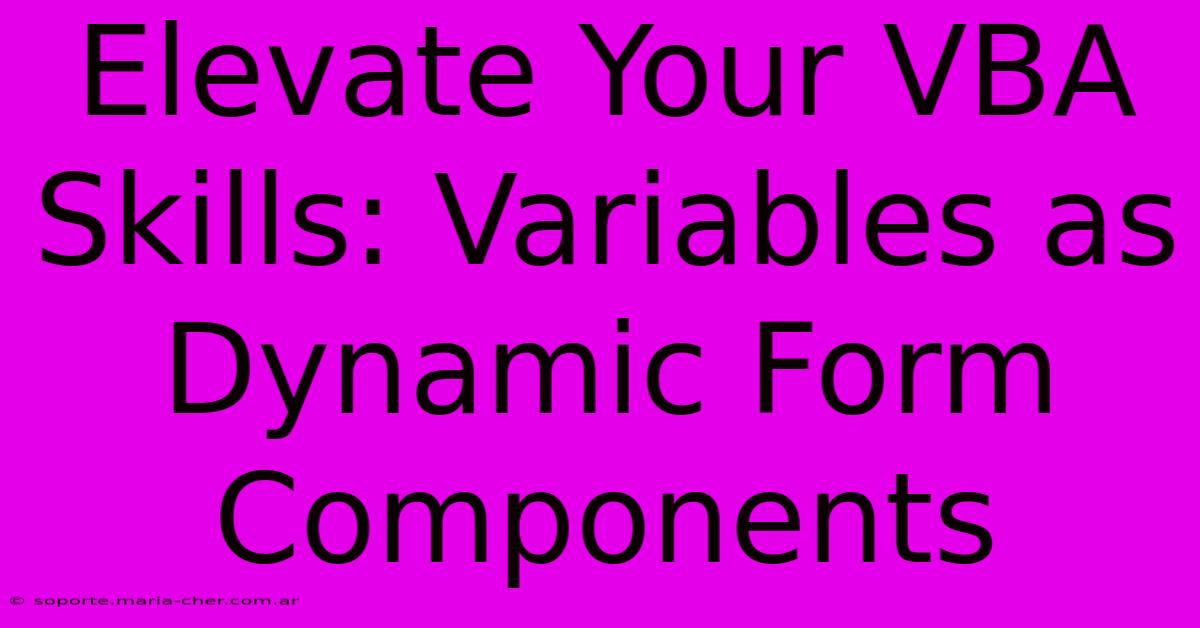Elevate Your VBA Skills: Variables As Dynamic Form Components

Table of Contents
Elevate Your VBA Skills: Variables as Dynamic Form Components
Visual Basic for Applications (VBA) offers incredible power for automating tasks within Microsoft Office applications. While many users leverage static forms, understanding how to dynamically create and manipulate form components using variables unlocks a whole new level of flexibility and efficiency. This article explores how to leverage variables to build dynamic forms, significantly enhancing your VBA programming capabilities.
Understanding the Power of Dynamic Forms
Traditional VBA forms are often static, meaning their design and components are fixed at design time. This limits adaptability. Dynamic forms, conversely, allow you to create, modify, and even remove form controls during runtime, based on user input, data changes, or other conditions. This adaptability dramatically improves the user experience and streamlines complex processes. By using variables to represent form components, you gain unprecedented control over your form’s appearance and behavior.
Benefits of Using Variables for Dynamic Form Components:
- Flexibility: Easily adjust the form's layout and content based on varying circumstances.
- Efficiency: Avoid the need for numerous pre-designed forms, saving development time and resources.
- User Experience: Create a more responsive and intuitive user interface that adapts to user actions.
- Maintainability: Cleaner, more organized code that is easier to understand and modify.
Implementing Dynamic Form Components with Variables
Let's delve into the practical aspects of using variables to dynamically manage form components. The core idea is to declare variables that hold references to the form controls you create at runtime.
1. Declaring Variables
First, you need to declare variables to hold your form controls. The data type will depend on the specific control. For example:
Dim txtName As TextBox
Dim cmdSubmit As CommandButton
Dim lblMessage As Label
These declarations create variables that can hold references to TextBox, CommandButton, and Label controls, respectively.
2. Creating Controls at Runtime
Next, use the Controls.Add method to create the controls. Assign the newly created control to your previously declared variable:
Set txtName = UserForm1.Controls.Add("Forms.TextBox.1", "txtName")
Set cmdSubmit = UserForm1.Controls.Add("Forms.CommandButton.1", "cmdSubmit")
Set lblMessage = UserForm1.Controls.Add("Forms.Label.1", "lblMessage")
This code snippet adds a TextBox, CommandButton, and Label to UserForm1 at runtime. The first argument specifies the control type, and the second argument assigns a name to the control (useful for later referencing).
3. Positioning and Properties
You can now set properties of these controls, such as their position, size, caption, and other relevant attributes, using the variable:
txtName.Left = 10
txtName.Top = 10
txtName.Width = 150
cmdSubmit.Caption = "Submit"
cmdSubmit.Left = 170
cmdSubmit.Top = 10
lblMessage.Left = 10
lblMessage.Top = 40
This code positions and styles the newly created controls.
4. Handling Events
Attach event procedures (like Click for a button) to dynamically created controls using the variable:
Private Sub cmdSubmit_Click()
' Your code here to handle the button click event
lblMessage.Caption = "Data Submitted!"
End Sub
This code connects the cmdSubmit_Click procedure to the cmdSubmit button, demonstrating how events are handled through the variable.
5. Removing Controls
You can also remove controls using the variable:
UserForm1.Controls.Remove "txtName"
This line removes the TextBox previously assigned to txtName.
Advanced Techniques
- Arrays of Controls: Use arrays to manage multiple dynamically created controls of the same type.
- Conditional Creation: Create controls only when certain conditions are met.
- Looping for Creation: Use loops to create multiple controls programmatically.
Conclusion
By mastering the use of variables to manage dynamic form components, you significantly expand the capabilities of your VBA applications. This approach allows for more adaptable, responsive, and user-friendly interfaces, making your code more efficient and easier to maintain. The techniques discussed in this article provide a solid foundation for building powerful and dynamic user experiences within your VBA projects. Start experimenting with these techniques to unlock the full potential of VBA form design!

Thank you for visiting our website wich cover about Elevate Your VBA Skills: Variables As Dynamic Form Components. We hope the information provided has been useful to you. Feel free to contact us if you have any questions or need further assistance. See you next time and dont miss to bookmark.
Featured Posts
-
Uber Reports Q4 And 2024 Results
Feb 06, 2025
-
Conference Room Nirvana The Essential Guide To Finding Your Perfect Fit
Feb 06, 2025
-
Orange You Intrigued Digging Into The Hidden Meaning Behind Home Depots Logo
Feb 06, 2025
-
Censori Almost Skipped Grammy Show
Feb 06, 2025
-
Love Joy Or Warmth Unveiling The Multifaceted Meaning Of Orange Roses
Feb 06, 2025
